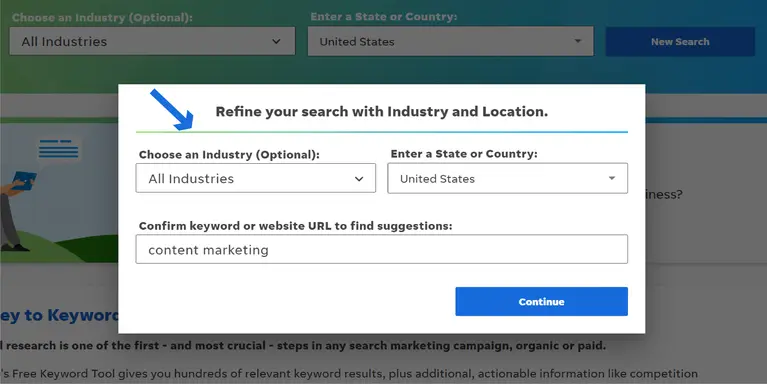
Enterprise SEO Keyword Research Tips
All businesses realize the importance of keyword research. Enterprises know that having solid keyword research can help them rank higher on search engine result pages (SERPs) and reach more potential customers.
Whether small or big your enterprise is, focusing on and building engaging content using relevant keywords can help you achieve numerous milestones.
Stay consistent and updated with whatever you do or your online business.
Tips To Gain Visitors For Your Enterprise Using These Keyword Research Tips
1. Analyze the Keywords Used by Competitors
Once you have selected the topic and have decided on the broad keywords, jump onto the competitor analysis.
Brands that are well aware of their competitors’ weaknesses and strengths know how to rise above them.
However, the competitor analysis does not mean selecting only the keywords your competitor is ranking for.
If your list has similar keywords, then it shows that you’re going in the right direction. Further, if you have plenty of new keywords, you can build valuable content.
For example, the screenshot below shows multiple keywords around “coffee that one can target.

Tools to use:
- BuzzSumo is one of the leading keyword analysis tools.
- Google Auctions Insights helps find your top-performing competitors and ranking.
- SpyFu is solely dedicated to competitive intelligence research.
2. Target Easy to Rank for Keywords
Every business wants to find keywords that are easy to target and rank for. This is because keywords are a primary source and the first step to ranking your business.
Tips to follow:
- Create a list of words by brainstorming with your team.
- Expand on this list by using advanced keyword research tools.
- Look for low-in competition keywords and search volume (at least 20). These keywords are the easiest to rank for but are difficult to gain traction from customers. So you need to be careful when you use them.
Tools to use:
- Google Adwords Keyword Research Tool is a go-to place to build your keyword list. Here you can create lists according to specific topics, location, language, etc. If you aren’t running active ads, it won’t show the details. Thus, you can use Google Keyword Planner to discover the search volume and competition.

- Keyword Surfer is a free chrome extension that helps see search volumes directly in Google search results.
- Topics by SEOMonitor curate all non-branded relevant keywords carefully.
3. Add head terms and long-tail keywords
Long-term keywords are specific keywords that users use when closer to the buying stage or using voice search to enter their search query. Thus, long-tails are valuable to the businesses as they are less competitive to rank for.
Besides, head terms are one or two-word keywords that drive high search volumes. They cater to broad categories such as sunglasses, pizza, shoes, marketing, classes, etc. This tells very little about the search query and the search details.
These are the broad categories in which you can classify your content and make pillars around it.
Tools to find long-tail keywords:
- Wordstream helps you get keywords and performance data to success in Google Ads and Bing Ads. It lets you segregate your niche and location to find the most suitable keywords.

- Long Tail Pro uses built-in engines that calculate the keyword competitiveness for any niche.
- Hubspot Content Strategy Tool helps rank for the topics that matter to you and your customers.
4. Focus on the Intent of the Keyword
Google’s changing algorithm is making it difficult to target keywords. Rather, it is not essential for content creators and enterprises to understand the intent behind the keywords. Understand that words without content hold no meaning. Consider, for example,
- Pizza
- Thin crust Pizza
- Discount on thin crust pizza
- Discount on thin crust pizza in San Antonio
What do you understand by this example?
In the first bullet, who can make out the search query's intent, is the user seeking pizza stores nearby, looking for pizza recipes, or just reading about the history of pizza; there is no clear intent to buy.
This is why Google tries to help them with search options.

The last bullet makes so much sense of the keyword as it ranks for a particular keyword.
5. Look for Keyword Variations
Keyword variation helps you connect with people looking for your business who have not entered the exact keyword but have slight variations in their search.
Though all the keywords can match close variations by default, there are still tricks to maximize your efforts.
However, target only one primary keyword and develop phrases relevant to the keyword to avoid keyword stuffing.
Tools to use:
- Google Search Console is a go-to tool for keyword variation stats. The screenshot below shows a wide range of keywords and their impressions.

- AnswerThePublic creates a list of every helpful phrase and question people ask around a particular keyword.
- Ubersuggest gives various keyword phrases and helps you get numerous options to select from.
6. Develop Content Around Customer Queries
As an enterprise, you provide valuable services to your customers, so it is essential to keep what your customers are looking for.
Developing content around the questions and queries that your customers might have is a ticket to winning their trust, establishing authority, and making a profit.
Creating content around “related search” queries will help grab users' and search engine attention.

Tips to Follow:
- Know your audience well and cater to their needs always.
- Engage with your audience on social media and seek their feedback/queries.
- Look at the related searches to know more about your customers' needs.
Tools to use:
- Facebook, Instagram, LinkedIn and Twitter, all social media platforms, have various tools and features to help you engage with your audience and get their responses in no time.
- AlsoAsked.com is a full-proof tool to get data on your interests.
- Google Trends is a valuable tool for knowing what is trending in your industry and developing content.
7. Aim for Location-Specific Keywords
Local keyword research is crucial to get found by potential local customers. As an example below, it helps secure a local 3-pack.

According to Think with Google, 76% of people who search for something nearby visit a related business within a day, and 28% of those searches result in a purchase. This shows that your local SEO tactics should be on point to maximize local queries' benefits.
Tips to follow:
- Make a Google My Business account and update all the necessary details.
- Use your primary keywords while describing your services, and be crisp and clear of whatever you say on GMB.
- Interact with the customers via the review section. And while replying to their comments, do mention the full name of your enterprise and the store's location.
Key Takeaways
- Analyze the Keywords Used by Competitors to know what is working for them and how you can produce better quality content.
- Target Easy to Rank for Keywords such as low-search volume keywords.
- Add head terms and long-tail keywords to cater to the specific search query.
- Focus on the Intent of the Keyword with the changing algorithms.
- Look for variations to target one primary keyword in multiple ways.
- Develop Content Around Customer Queries and be the first one to provide them with solutions to their problems.
- Aim for Location-Specific Keywords to rule the local markets.
ABOUT THE AUTHOR:
Brice Decker

Brice has been handling marketing projects for more than 12 years and he is providing consulting services on SEO, Social Media and PPC. He has a huge expertise in working at large corporations including Accenture Interactive & PwC Digital Services.
ABOUT THE AUTHOR:
Brice Decker

Brice has been handling marketing projects for more than 12 years and he is providing consulting services on SEO, Social Media and PPC. He has a huge expertise in working at large corporations including Accenture Interactive & PwC Digital Services.
Related Post
How to Rebrand Your Business Without Losing SEO?